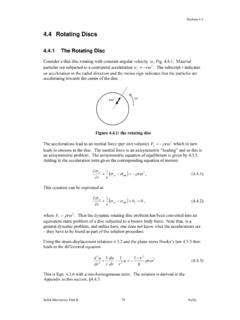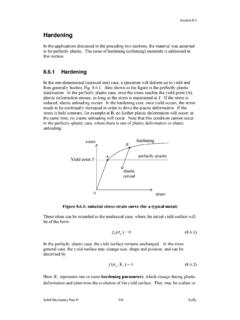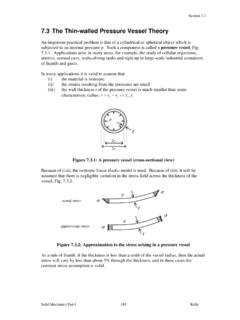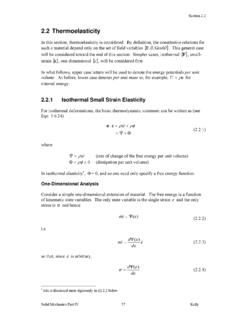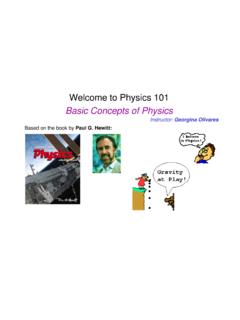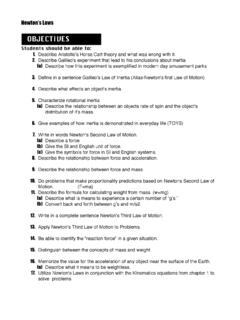Transcription of 2.1 The Fundamental Concepts and Principles of Mechanics
1 Section Solid Mechanics Part I Kelly The Fundamental Concepts and Principles of Mechanics The Fundamental Concepts The four Fundamental Concepts used in Mechanics are space, time, mass and force1. It is not easy to define what these Concepts are. Rather, one knows what they are, and they take on precise meaning when they appear in the Principles and equations of Mechanics discussed further below. The concept of space is associated with the idea of the position of a point, which is described using coordinates ),,(zyx relative to an origin o as illustrated in Fig. Figure : a particle in space The time at which events occur must be recorded if a material is in motion. The concept of mass enters newton s laws (see below) and in that way is used to characterize the relationship between the acceleration of a body and the forces acting on that body.
2 Finally, a force is something that causes matter to accelerate; it represents the action of one body on another. The Fundamental Principles The Fundamental laws of Mechanics are newton s three laws of motion. These are: newton s First Law: if the resultant force acting on a particle is zero, the particle remains at rest (if originally at rest) or will move with constant speed in a straight line (if originally in motion) By resultant force, one means the sum of the individual forces which act; the resultant is obtained by drawing the individual forces end-to-end, in what is known as the vector 1 or at least the only ones needed outside more advanced topics xyz particle p oSection Solid Mechanics Part I Kelly 12polygon law; this is illustrated in Fig.
3 , in which three forces 321,,FFF act on a single particle, leading to a non-zero resultant force2 F. Figure : the resultant of a system of forces acting on a particle; (a) three forces acting on a particle, (b) construction of the resultant F, (c) an alternative construction, showing that the order in which the forces are drawn is immaterial, (d) the resultant force acting on the particle Example (illustrating newton s First Law) In Fig. is shown a floating boat. It can be assumed that there are two forces acting on the boat. The first is the boat s weight gF. There is also an upward buoyancy force bF exerted by the water on the boat. If these two forces are equal and opposite, the resultant of these two forces will be zero, and therefore the boat will remain at rest (it will not move up or down). Figure : a zero resultant force acting on a boat The resultant force acting on the particle of Fig.
4 Is non-zero, and in that case one applies newton s second law : 2 the construction of the resultant force can be regarded also as a principle of Mechanics , in that it is not proved or derived, but is taken as given and is borne out by experiment bFgF 1F2F3FF2F3F1F(a)(b) F(d)(c)2F1F3 FFSection Solid Mechanics Part I Kelly 13 newton s second law : if the resultant force acting on a particle is not zero, the particle will have an acceleration proportional to the magnitude of the resultant force and in the direction of this resultant force: aFm ( ) where3 F is the resultant force, a is the acceleration and m is the mass of the particle. The units of the force are the newton (N), the units of acceleration are metres per second squared (m/s2), and those of mass are the kilogram (kg); a force of 1 N gives a mass of 1 kg an acceleration of 1 m/s2.
5 If the water were removed from beneath the boat of Fig. , a non-zero resultant force would act, and the boat would accelerate downward4. newton s Third Law: each force (of action ) has an equal and opposite force (of reaction ) Again, considering the boat of Fig. , the water exerts an upward buoyancy force on the boat, and the boat exerts an equal and opposite force on the water. This is illustrated in Fig. Figure : newton s third law; (a) the water exerts a force on the boat, (b) the boat exerts an equal and opposite force on the water newton s laws are used in the analysis of the most basic problems and in the analysis of the most advanced, complex, problems. They appear in many guises and sometimes they appear hidden, but they are always there in a Mechanics problem. 3 vector quantities, that is, quantities which have both a magnitude and a direction associated with them, are represented by bold letters, like F here; scalars are represented by italics, like m here.
6 The magnitude and direction of vectors are illustrated using arrows as in Fig. 4 if we set F to be zero in newton s second law , we get 0 a, which seems to be saying the same thing as newton s First Law, and in fact it appears to imply that newton s First Law is redundant. For this reason, newton s First Law is not actually used in analyzing problems (much); it is necessary only to deal with different frames of reference. For example, if you stand in an accelerating lift (your frame of reference) with glass walls, it appears to you that you are stationary and it is the outside (a different reference frame) which is accelerating, even though there is no force acting on the outside , which appears to be a contradiction of newton s second law . newton s First Law discounts this option: it says that when the force is zero, the body remains at rest or at uniform velocity.
7 newton s First Law implies that newton s Laws only apply to Inertial Frames, frames of reference in which a body remains at rest or uniform velocity unless acted upon by a force bFbF (a)(b)surface of water

